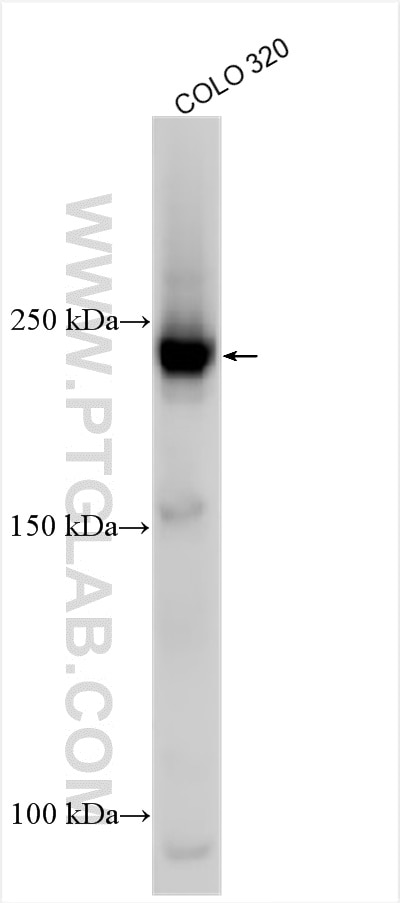Tested Applications
| Positive WB detected in | COLO 320 cells |
Recommended dilution
| Application | Dilution |
|---|---|
| Western Blot (WB) | WB : 1:500-1:2000 |
| It is recommended that this reagent should be titrated in each testing system to obtain optimal results. | |
| Sample-dependent, Check data in validation data gallery. | |
Product Information
31795-1-AP targets BRWD3 in WB, ELISA applications and shows reactivity with human samples.
| Tested Reactivity | human |
| Host / Isotype | Rabbit / IgG |
| Class | Polyclonal |
| Type | Antibody |
| Immunogen | BRWD3 fusion protein Ag36948 Predict reactive species |
| Full Name | bromodomain and WD repeat domain containing 3 |
| Calculated Molecular Weight | 204 kDa |
| Observed Molecular Weight | 240 kDa |
| GenBank Accession Number | BC039508 |
| Gene Symbol | BRWD3 |
| Gene ID (NCBI) | 254065 |
| Conjugate | Unconjugated |
| Form | Liquid |
| Purification Method | Antigen affinity Purification |
| UNIPROT ID | Q6RI45 |
| Storage Buffer | PBS with 0.02% sodium azide and 50% glycerol, pH 7.3. |
| Storage Conditions | Store at -20°C. Stable for one year after shipment. Aliquoting is unnecessary for -20oC storage. 20ul sizes contain 0.1% BSA. |
Background Information
Bromodomain and WD repeat-containing protein 3 (BRWD3) is thought to regulate gene expression through its interactions with chromatin. BRWD3 promotes the K48-linked polyubiquitination and degradation of KDM5, which depends on BRWD3 and Cul4. This function is critical for maintaining H3K4 methylation levels and regulating gene expression (PMID: 37722046). Mutations of BRWD3 are associated with a spectrum of cognitive disabilities and X-linked macrocephaly (PMID: 17668385).
Protocols
| Product Specific Protocols | |
|---|---|
| WB protocol for BRWD3 antibody 31795-1-AP | Download protocol |
| Standard Protocols | |
|---|---|
| Click here to view our Standard Protocols |



